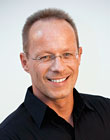Does a 2,000-Year-Old Statue Belong at Your Meeting?April 1, 2013
By Walter StuggerDoes a 2,000-Year-Old Statue Belong at Your Meeting?
 Walter Stugger is co-founder of inspiria event service GmbH, helping companies and organizations meet successfully in Europe and beyond. People chose Inspiria for local connections across Europe, for access to cultural traditions and authentic expressions, and for events that are always unique and client-specific. Contact Stugger at w.stugger@inspiria.net and visit online at www.inspiria-global-events.com.
Walter Stugger is co-founder of inspiria event service GmbH, helping companies and organizations meet successfully in Europe and beyond. People chose Inspiria for local connections across Europe, for access to cultural traditions and authentic expressions, and for events that are always unique and client-specific. Contact Stugger at w.stugger@inspiria.net and visit online at www.inspiria-global-events.com.
At a global meeting our company helped produce in Rome, one of the main attractions never moved a muscle. I did the booking but didn’t complain. After all, the talent was nearly 2,000 years old.
The attraction was a statue, the well-preserved bust of Emperor Diocletian. The sculpture resided permanently within the ancient thermal baths that are among the surviving glories of ancient Rome. We had secured unusual private access to the renowned Baths of Diocletian, and I am sure the breathtaking setting and the emperor’s compelling visage assured all arrivals this meeting would not be business as usual.
At our client, Infineon Technologies AG, expectations ran high. How could we harness the power of history and the arts to motivate the global network of Infineon distributors who constituted the meeting’s invitees — executives from around the world coming to talk about technology trends and market demands, business channels and profit margins? They had so much on their minds besides antiquity and aesthetics. How would they react?
No One Slept!
Our creative team set to work, animating the emperor through adroit use of pin lights. A troop of modern dancers performed around the statue, using choreography created for the occasion. Chefs got busy cooking meals inspired by Cucina Romana. Puccini arias serenaded us and bestowed a name to the event: “Nessun Dorma.” At this meeting, surely no one slept!
One of the Infineon distributors greeted me the next morning. “Walter,” he began, “last night was remarkable! I could feel this 2,000-year-old legacy. The art, the music, the sense of continuity with the classical world were amazing. But at the same time it was so contemporary and with all the technology being used.”
I appreciated his comments and was especially proud when our program earned the gold prize for corporate meetings at the Austrian Event Award competition last year.
We consider the arts to be our partners around the world. While fine artists thrive around the globe, we consistently look to showcase them in their own environment. In our experience, the environment is a major factor in both the creation of art and its reception.
Vital Qualities for Gatherings
Art is the ultimate flexing of the creative muscle. It provides inspiration and sustenance through the gifts of painters and poets, sculptors and choreographers.
This is by no means limited to organizations dedicated to cultural achievement. It was Albert Einstein who said, “Logic will take you from A to B. Creativity will take you everywhere.” Einstein understood that cultural achievement produces creativity, inspires collaboration and spurs innovative thinking in all walks of life. These are vital qualities for every gathering.
Maybe it runs in my blood. I was born and raised in Salzburg, the famous hometown of Wolfgang Amadeus Mozart. I began my career as a licensed Salzburg tour guide, introducing visitors to the streets and cafés, the history and the abiding culture that nurtured the great composer. Walking through the town we both knew so well, I helped connect contemporary visitors with the composer’s historical life. The composer was never Herr Mozart to me, he was mischievous Wolfgang! Without setting out to overthrow the standard tour, I was merely introducing visitors to an old friend. The connection and the passion I felt both made a difference, I think.
My experience introducing Wolfgang to visitors from around the world taught me lessons I will never forget. I learned the power of the arts to inspire is remarkable and enduring. The sweep of opera, the impact of theater, the excitement of dance — the arts embrace us, stimulate us, push us to create and collaborate. The arts drive us to banish the predictable and incubate the exceptional. The arts move us to transcend the limitations of today, nurturing the potential of tomorrow.
I urge you to put my suggestion to the test. Prior to your next event, go out and discover the local poets, the regional authors, the city’s great painters. Find ways to integrate them into your program. Bring the culture of the community into the exposition center, make the most of the location, and watch the difference it makes.
In Salzburg you can still hear the laughter of young Mozart in the streets; you just have to know how to listen. C&IT








